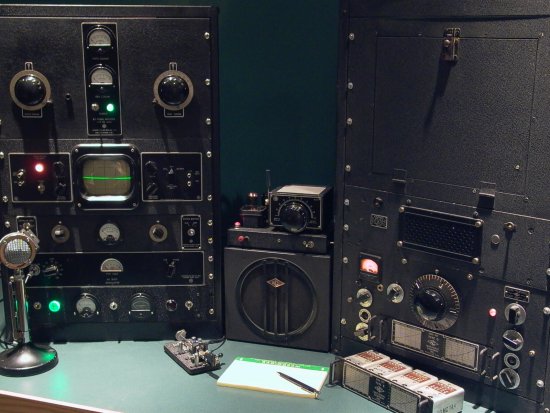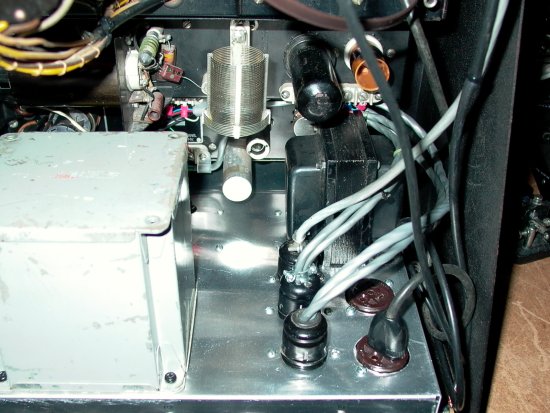The James Millen Society
|
Dennis
Petrich, KØEOO
|
|
FIGURE 1 - This shows
the completed James Millen 500w transmitter in
my shack connected up with a 1946 vintage
HRO-5RA1. The 90700 Vari-arm VFO is setting on
top of the HRO-5 speaker. In the photo, you
can see the two meters and the green and red
lights on the bottom panel of the transmitter;
that is the front panel of the power supply
for the tabletop portion of the transmitter.
The Millen modules, from top to bottom are the
90881-500w RF deck with 812A tubes running
class C. The 90905 5" scope to monitor the RF
envelop or trapezoid pattern. The 90800-50w
exciter with 6L6 and 807 and the 90831-speech
amp with 6146's in its output driving the
grids of the 811A's in class B in the power
modulator. FIGURE 2 - The high
voltage power supply and the power modulator.
View schematics of the power supply and
modulator here! The choke
to the right is in series with the HV to the
RF deck. The modulation iron is in the back at
the left on the other side of the 811A tubes.
The mod iron is capacitively coupled across
the choke to take the DC off the mod iron
secondary; a trick used in many broadcast
transmitters. You can see the interconnect
cables at the right of the chassis and the two
chokes and the HV transformer on the right
side of the chassis. The three relays near the
center are for Tune/operate, CW/Phone and
Plate ON/OFF control. FIGURE 3 - The bottom
side of the HV supply and power modulator. I
chose to connect two smaller chassis vs. one
larger chassis due to the weight of all the
transformers. The trick worked pretty well but
I think a steel chassis would have been even
sturdier. The power supply filters are on the
right and the coupling cap for the modulation
is at the top with one of the CW/Phone relays
at top left. The small circuit board between
the relay and the capacitor is the negative
cycle loading circuit. In the lower right of
the chassis is the plate relay and at the top
right is the filament transformer for the
811A's or the TZ-40's. At this time, I'm using
811A's because with 1450 volts the zero signal
plate current is about 60ma. The zero signal
plate current with the TZ-40's is higher so I
would need to add about -9 volts of bias to
run those tubes correctly. FIGURE 4 - Top view of
the high voltage power supply and power
modulator. To the left of the 811A's is the
mod iron and to the right of the tubes is the
25H modulation choke. The plate transformer is
center back, the swinging choke is back left,
and the smoothing choke is back right. FIGURE 5 - Back of the
transmitter. The bottom chassis is the
homebrew supplies for the exciter, speech amp,
VFO, and AC power for the RF decks filament
supply. The bias supplies are located on this
chassis. FIGURE 6 - Notice the
multi-pin plugs; each one is for a different
Millen module. This way I can easily remove
one of the modules for repair. The two-120v
outlets in the foreground are switched from
the filament ON/OFF switch. One is for the
90905 scope and the other has an isolation
transformer for the 90700 VFO. The 90700 VFO
is an AC/DC design that doesn't like being
connected to a circuit with a ground fault
detector. FIGURE 7 - Bottom view
of the low voltage supplies for the modules in
the tabletop transmitter. This supply includes
the 500v for the exciter and speech amp. The
240v for the speech amp and the three -45v
bias supplies for the RF deck, speech amp and
the exciter. The filament supply for the
speech amp and exciter is on this chassis as
is all of the switching circuits for the
entire transmitter; plate switch, filament
switch, tune/operate switch, exciter grid
current meter and modulation cathode current
meter. The CW/Phone switch is located on the
90831-speech amp and controls two relays on
the HV supply to switch the transmitter from
Phone to CW. Look at the schematics for
details. |






